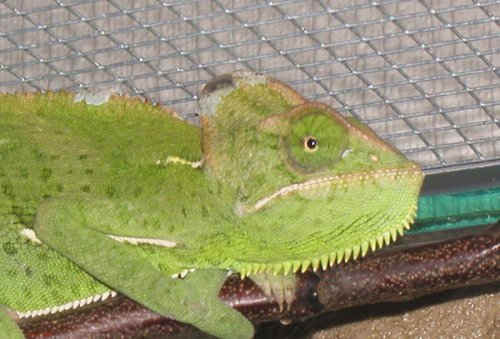netweaver
New Member
Hi you guys!
I have a question from sweden, my first in this forum (sorry for my bad english hope you understand).
I have a veiled chameleon approx 8 months now, and the problem is when she sheds her skin there has for the last months been som "left" behind on the helm (not sure if it's called that on top of the head). This has resulted in som black skin on top of the head, this is not spreading and she is in good condition otherwise. But every time she sheds it's always the last part of her to shed of the old skin. Should i assist with taking of the old skin och just leave it as is? Or could it be a disease?

I attached a picture.
As i know the setup is not much at all as yours living in a totally different climate than me, i have a semi-netted enclosure 120cm high 70cm with and 60cm deep.
It's filled with different types of plants and lots of branches for her to climb but her favorite spot is at the very top next to the lamps.
I have a Uv-lamp inside the enclosure and a 100w on top for heat.
The humidity is keept by a rain-system with reverse osmosis water, the heart of this system is a Seisun pump.
Im asking this question in your forum as we don't have much forums like this in sweden, nor any speciallist vet nearby. Once again sorry for my bad english/us.
I have a question from sweden, my first in this forum (sorry for my bad english hope you understand).
I have a veiled chameleon approx 8 months now, and the problem is when she sheds her skin there has for the last months been som "left" behind on the helm (not sure if it's called that on top of the head). This has resulted in som black skin on top of the head, this is not spreading and she is in good condition otherwise. But every time she sheds it's always the last part of her to shed of the old skin. Should i assist with taking of the old skin och just leave it as is? Or could it be a disease?

I attached a picture.
As i know the setup is not much at all as yours living in a totally different climate than me, i have a semi-netted enclosure 120cm high 70cm with and 60cm deep.
It's filled with different types of plants and lots of branches for her to climb but her favorite spot is at the very top next to the lamps.
I have a Uv-lamp inside the enclosure and a 100w on top for heat.
The humidity is keept by a rain-system with reverse osmosis water, the heart of this system is a Seisun pump.
Im asking this question in your forum as we don't have much forums like this in sweden, nor any speciallist vet nearby. Once again sorry for my bad english/us.




